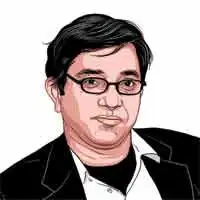Opinion The year of living angrily
The friction between democracy and markets may be inevitable in India today,and only skilful politics can resolve it
Was 2011 a year of democratic splendour,or a year of democratic squalor? The latter term is not often used. But if you asked Lee Kuan Yew,the architect of modern Singapore,he would not hesitate to use it for India.
How else,he would say,can one characterise a year whose key features were as follows: a democratically elected Parliament spent more time adjourning legislative proceedings than participating in them; non-elected civil society activists threatened to take over legislation from those elected to make laws; farm unrest made it virtually impossible for industrialists to acquire land for industrialisation,something India badly needs; protests forced the government to put on hold a much-needed reform of retail trade that would have benefited millions of farmers and consumers.
Viewed from a different prism,however,the same events,with the exception of parliamentary adjournments,would qualify as splendid democratic victories. Protests against unwelcome government policies,or against the misconduct of rulers,are entirely democratic. Democracy cannot be equated with elections alone: elections are necessary,not sufficient. Whether citizens can check governmental authority between elections is a significant indicator of a politys democratic health.
Using democratic modes,three different groups rebelled this year: the urban middle class against corruption,farmers against land acquisition,traders against reform of retail. All three groups are numerically large. On the domestic front,the Central government remained paralysed for much of the year. Even when the government tried to break the logjam,it would move forward only to pull back. This can be read as a narrative of government bowing to citizen preferences. What could be more democratic?
Each of the two narratives above contains an element of truth,but neither is entirely adequate. To understand some of the underlying dynamics of Indian democracy today,we need to put it in the context of post-1991 realities. Indias democracy now coexists with rising capitalism. Serious tensions between democracy and markets have by now emerged. That is what produced the anger of 2011. That is why the government is paralysed.
Consider three of the biggest events of the year. Facing an urban land constraint,Indias capitalism badly needs to acquire agricultural lands for industrial and commercial use. But farmers have hit back. They will offer land only when the proposed commercial acquisition demonstrably serves their interests as well.
To reduce the enormous waste in the farm-to-store supply chain and to create value for itself,consumers and farmers,Indias capitalism also wishes to bring modern techniques of refrigeration,logistics and retail to the country. But,using perfectly legitimate modes of lobbying and protest,traders have successfully pushed reform back,at least for now. Indeed,the reversal was a surprising outcome of the clash between democracy and markets. As Nehru hinted in The Discovery of India and political observers have known for decades,the trader,the customary bania,has never enjoyed political legitimacy in India. But the first week of December produced the triumph of the bania.
Finally,consider the years most vociferous expression of anger,the Anna Hazare-led anti-corruption movement. Though Hazare is both against crony capitalism at the higher levels of the polity as well as routine corruption at the lower bureaucratic tiers,it is the 2G scam that brought him to Delhi. People beyond Maharashtra had not heard of him until March 2011. Telecom crony capitalism gave him a national halo,and a democratically legitimate movement was born.
Capitalism has always had at least two sides: innovation and cronyism. Freedom to do business often generates innovative entrepreneurialism. Google,Apple and Amazon have not only produced fortunes for their share holders,but also benefited millions of consumers all over the world.
Search for profits can,however,also lead to collusion between government and business. Post-1991 India might have produced an Infosys,as also quite a few Dalit millionaires. But it has also had a 2G scam and multiple mining and land scandals.
India is not alone in experiencing crony capitalism. As they rose economically,Japan in the 1950s and 1960s,and South Korea in the 1970s and 1980s,also had a lot of cronies promoted by the state. In the second half of the 19th century in the US,christened the Gilded Age by Mark Twain,the rise of industrial capitalism was accompanied by corrupt politician-business links.
Whether or not authoritarian polities rebel against such collusion,democratic polities tend to. Faced with political pressures,Japan,South Korea and the US had to clean up the business environment,substantially if not wholly. Something similar might happen in India.
Can the anger of 2011 be a source of political creativity? Resolving the tensions between democracy and markets requires imagination and skilful political communication. Consider examples:
Reform of retail trade heavily favours farmers and consumers. Their numbers far outweigh those of the trading community which,though organised,has little mass legitimacy. That government could not make numbers and legitimacy count over organisation shows how poor the governments communication strategy was.
The clash between farmers and industrialisation can be handled,if farmers are given stakes in the commercial use of land without entirely killing profits for the industrialist. A new political understanding,mediated by government and historically made in most industrialising democracies,is necessary. That rural welfare requires the eclipse of agriculture is a law of economic development. Rural folk need to be connected to larger markets. If one leaves peasants on land for ever,one only perpetuates their poverty. Agriculture can at best grow at 4-5 per cent per annum; industry can easily grow at twice that rate.
Finally,a Lokpal will reduce corruption at the top,but crony capitalism cannot be fully defeated unless the dependence of Indias elections on big money is broken. When will Indias political leadership boldly step forward,make that point and do something about it?
The writer is Sol Goldman Professor of International Studies and the Social Sciences,and Director,India Initiative,Brown University





